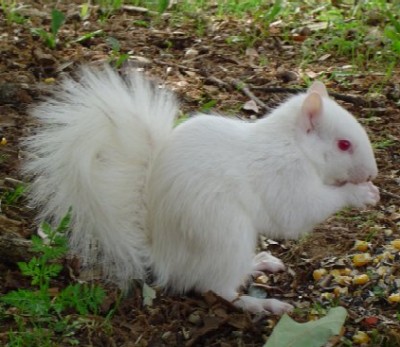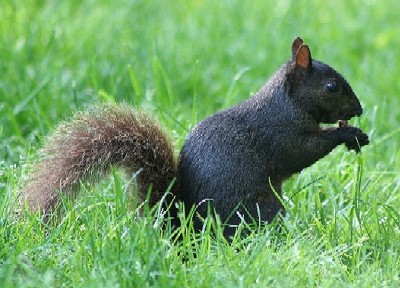
November 30, 2006
Here are two new fun lists for 2006. They represent my top ten choices (each) of white and black squirrels’ hot spots tied to their sightings and appearances. White squirrels are infrequently albino (with pink eyes) and more often near-albinos (with dark eyes). The more numerous melanistic and near-melanistic (often looking brown) squirrels are celebrated as black squirrels. The guidelines and criteria for these sites’ rankings on my lists are via a complex and comprehensive formula based on the significance of the population, media attention they are demanding, local interest levels, and my personal biases.

One of Olney’s Finest.
2006’s Top Ten White Squirrel Locations
1. Portland, Maine. This city has been assisted the #12 spot in Frommer’s new list of the top world destinations in 2007, as I mentioned yesterday. Now it turns out, the city has a new attraction, recent sightings of one lone white squirrel in its Longfellow Woods. It has been photographed but that image is not online yet. Melanie Creamer’s Portland Press Herald story of November 29, on page B-5, never made it to the newspaper’s website either. Nevertheless, it is a breaking story, discussed around town. Are there more? Will the Longfellow Woods be full of white squirrels in a decade? Will laws to protect Portland’s lone white squirrel be passed soon. This has to be the number one pick, because the sighting is almost being discussed like its a miracle appearance of a white buffalo. Stay tuned.
2. Olney, Illinois. Although at one time, there were 1000 white squirrels here, today the number is around 200. The town is well-known, since 1902, for its white squirrel population. They are protected in the town, which has become a major tourist attraction based largely on the fact they have called the city, “Home of the White Squirrels.”
3. Marionville, Missouri. Also publicized as “Home of the White Squirrels.” The town claims to possess the largest, oldest colony of white squirrels in the world, around 300 to 600, here since at least 1854. “The squirrels in Olney were kidnapped from Marionville,” the town’s literature says.
4. Exeter, Ontario. The town has a sizable population of white squirrels. Lucky lottery coins have been produced linked to these white squirrels, as has several types of souvenirs. There is an annual White Squirrel Festival here.
5. Brevard, North Carolina. Yet another “Home of the White Squirrels.” Brevard College’s “White Squirrel Research Institute” has charted the geographic distribution of their famed near-albino residents. Brevard’s white squirrels are legally protected. The town holds a White Squirrel Festival, around Memorial Day Weekend.
6. Kenton, Tennessee. About 200 white squirrels exist here. But are they growing rarer here? The town no longer celebrates it’s white squirrel population in any large fashion.
7. Oberlin College, Ohio. There are a few albino squirrels roaming College and Tappan Square.
8. Northern Keys, Florida. Another white squirrel colony.
9. Charlotte, North Carolina. Yet another one.
10. University of Texas at Austin. Founded in April, 2001, by Dustin Ballard at the University of Texas at Austin, the Albino Squirrel Preservation Society (ASPS) exists as an international collegiate organization dedicated to “fostering compassion and goodwill” toward albino squirrels, first seen in Austin. About 700 ASPS members are now in chapters formed at the University of North Texas, the University of Pennsylvania, the University of Western Ontario, Cambridge University, Texas A&M University, Illinois State University, the Juilliard School of Music, and Concord High School in Concord, California, where all supposedly have white squirrels on their campuses. Honorable mention must go to the University of Louisville, too, which reportedly has had white squirrels since the 1930s.
I would assume that these “newer” locations are being set up by the specific “seeding” of campuses with one or two white squirrels. However, not all of these experiments end in established populations, if the following is typical:

The Once And Future University of North Texas White Squirrel.
University of North Texas, Texas. A single albino squirrel here representing academic fortune was “discovered” in 2002. Therefore, a chapter of the Albino Squirrel Preservation Society was formed on behalf of the squirrel. (Or was the chapter formed first, and then the white squirrel brought here?) Tragically, on the morning of August 21, 2006, the albino squirrel was the prey of a hawk and was pronounced dead.

One of Washington State’s Black Squirrels, perhaps a former Canadian?
2006’s Top Ten Black Squirrel Locations
1. National Zoo, Washington, D. C. I’ve personally seen these black squirrels on my zoological field visits here for over 30 years. The black squirrels are well-fed by the zoo visitors waiting to see the giant pandas, and, needless to say, naturally protected in these surroundings.
2. Marysville, Kansas. With some justification, this is the “Home of the Black Squirrels.” It has named the black squirrel its official mascot, complete with an annual “Black Squirrel Celebration” and its own song. The black squirrels here are protected by local laws. (Footnote: Hobbs, New Mexico. The town transplanted some black squirrels from Marysville, Kansas, in 1973. However, they have been all killed in recent years by the fox squirrels the town imported from Texas.)
3. Council Bluffs, Iowa. The town has been the home of black squirrels since at least the 1840s.
4. London, Ontario. There is a sizable native population of black squirrels here, that are the source of Kent State’s now successful colony.

5. Kent State University, Kent, Ohio. The black squirrel is the unofficial mascot of the school, with a black squirrel road race and an annual “Black Squirrel Festival,” since 1981. All the black squirrels originated in 1961 from ten original black squirrels that were transported to the campus from London, Canada, by Larry Woodell, superintendent of grounds, and M. W. Staples, a retired executive of the Davey Tree Expert Company. (Mount Union College, about an hour away from Kent State, is also home to a large population of black squirrels.)
6. Princeton, New Jersey. The famed university town has a population of melanistic Eastern gray squirrels.
7. Albion College, Michigan. The black squirrels here have become a defining symbols of the college. Michigan State University has some sightings too.
8. University of Maryland, College Park, Maryland. Black squirrel sightings have been reported from this location.
9. University of British Columbia, Vancouver, British Columbia. The black squirrels here reached urban legend status here, as they are said to be extremely large, compared to a plague, and felt to be like rats around campus. Black squirrels were introduced to the Stanley Park Peninsula in Vancouver, British Columbia, prior to 1914 and have now spread from Vancouver, into the North Shore and the Fraser Valley area surrounding the city. Reportedly, as well, these squirrels have migrated from Vancouver into Whatcom County, in northwest Washington State.
10. Bronx Zoo and Manhattan’s Central Park and Peter Cooper Village, New York City. A thriving population of black squirrels are found in these Big Apple sites.
[Non-America note: Black squirrels today are also seen in the towns of Letchworth Garden City and the Chiltern Hills area of Baldock in Hertfordshire, England, and the villages of Girton, Madingley and Oakington near Cambridge, United Kingdom.]
Squirrel Sightings Are Not Easy
A note about searching for these squirrels: Avoid harassing the wildlife and don’t get too frustrated looking for white or black squirrels. Yes, it may seem like a no-brainer to observe a squirrel, but it does not come easily when you are narrowing your focus.
A rather well-known great white squirrel hunter named Craig S. Thom has traveled throughout North America photographing his prey (his pic of one pair, a black one and a white one together, is outstanding – see the link below).
Your luck may be no better than Thom’s, for example, where he mentions on his website that he only saw one white squirrel in Olney, Illinois, and after searching and searching, finally came upon only one pair in Kenton, Tennessee.
If this guy can barely find these animals to photograph their images, even though they live in large, well-publicized, open populations, why should we be surprised Bigfoot are not captured on film more often?
Why is this of interest to a cryptozoologist? I talk about that in a separate blog today, here.
About Loren Coleman
Loren Coleman is one of the world’s leading cryptozoologists, some say “the” leading living cryptozoologist. Certainly, he is acknowledged as the current living American researcher and writer who has most popularized cryptozoology in the late 20th and early 21st centuries.
Starting his fieldwork and investigations in 1960, after traveling and trekking extensively in pursuit of cryptozoological mysteries, Coleman began writing to share his experiences in 1969. An honorary member of Ivan T. Sanderson’s Society for the Investigation of the Unexplained in the 1970s, Coleman has been bestowed with similar honorary memberships of the North Idaho College Cryptozoology Club in 1983, and in subsequent years, that of the British Columbia Scientific Cryptozoology Club, CryptoSafari International, and other international organizations. He was also a Life Member and Benefactor of the International Society of Cryptozoology (now-defunct).
Loren Coleman’s daily blog, as a member of the Cryptomundo Team, served as an ongoing avenue of communication for the ever-growing body of cryptozoo news from 2005 through 2013. He returned as an infrequent contributor beginning Halloween week of 2015.
Coleman is the founder in 2003, and current director of the International Cryptozoology Museum in Portland, Maine.
Filed under Breaking News, Cryptomundo Exclusive, Cryptotourism, CryptoZoo News, Cryptozoologists, Cryptozoology, Eyewitness Accounts, Pop Culture